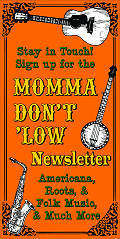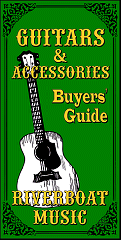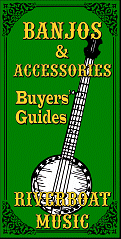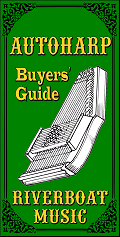



|
Chromatic 21-Chord Tweaking Overview
Many people who've played autoharps for a while begin to think that there must be a better key layout for the kinds of material they like to do. Even folks who thought their 21-chorders were the key to autoharp happiness.
Yes, most autoharp experts will recommend starting on a 21-chorder if you can afford it, but that's not the end of the story.
As examples:
- Folks who play traditional music forms such as Folk and Bluegrass may find themselves wishing they had chords like E major and F#m. And wishing, say, that Em was closer to G.
- On the other hand, folks who play mid-century American popular music or - ironically - ancient hymns and Christmas carols will find themselves wishing their autoharps had diminished chords*.
- A few folks have gotten away from the one-chord-bar-per-chord setups altogether, and they say it's made everything better for them.
Fortunately, 21-chorders are easy to tweak. And if you don't mind buying extra chord bars to do your experimentation with, you can even switch things back if you decide you made the wrong choice.
That said, it can create quite a mess while you're doing the work, and some folks get overwhelmed - I've acquired at least two 21-chorders cheap from folks who tried a major conversion, got overwhelmed, threw everything back in the case, and took it to Goodwill.
Don't Try This At Home (Yet). This page is simply an overview of some of the ways people reconfigure their 21-chord autoharps to better suit their needs, while still leaving them "chromatic," that is, able to play in many keys. You shouldn't attempt any of these tweaks until you have studied the 21-chord section of our Autoharp Repair Overview page, at least. But if you have a 21-chorder and you've been thinking, "It would sure be nice if Am was closer to C," or some such, this page can hopefully point you toward useful suggestions.
Which Modifications Will Be Best for You? As you learn and/or struggle with your 21-chorder, you will discover for yourself what chords you seem to be missing, and which chord bars you need to be closer to which other chord bars. The following sections describe some of the most common kinds of modification.
"Folk-Friendly" Setups
These approaches are favored by people who like genres that tend to be dominated by acoustic instruments like guitar, banjo, and fiddle. They add chords like E major, B minor, and F# minor that are frequently used in guitar- and fiddle-friendly keys like G, D, A, and E.
 Simplest Approach - It's possible to add those chord bars, and sacrifice chords you'll never use like Ab, Bb7, and F7, while still leaving most of the chords in the same relative position. In fact, if you have a 21-chord Chromaharp, that may be your best approach. Simplest Approach - It's possible to add those chord bars, and sacrifice chords you'll never use like Ab, Bb7, and F7, while still leaving most of the chords in the same relative position. In fact, if you have a 21-chord Chromaharp, that may be your best approach.
For one example of this approach, check out our article "Simplest Folk Chord Addition for 21-Chorders."
An additional feature of this sort of reconfiguration is that you can change it back later if you wish, or you can change it further to a setup many folks prefer: some version of the Bowers setup.
 Modified "Bowers" Approach - Decades ago, autoharper Bryan Bowers experimented with moving the chords around so that the top row of buttons is mostly seventh chords, the middle row is mostly major chords, and the bottom row is mostly minor chords. All three rows are in "circle-of-fifth" sequence as much as possible, which makes transposition easier for folks who know music theory. (Bb/F/C/G/D/A/E, etc.) Modified "Bowers" Approach - Decades ago, autoharper Bryan Bowers experimented with moving the chords around so that the top row of buttons is mostly seventh chords, the middle row is mostly major chords, and the bottom row is mostly minor chords. All three rows are in "circle-of-fifth" sequence as much as possible, which makes transposition easier for folks who know music theory. (Bb/F/C/G/D/A/E, etc.)
Technically, Bowers never used half of the versions of this setup that are attributed to him, and he probably wishes there was another name for it. The picture above right shows the version that Oscar Schmidt uses on their "Americana" autoharps, and it's one of the most common. As a Folk singer, I find that one advantage of these setups is that, in addition to giving me E, Bm and F#m, they bring the relative minors closer to their major keys.
If you have a standard Oscar Schmidt 21-chorder and you're fine with the the setup shown above right, you may be able to buy store-bought chord bars for your 21-chord Oscar Schmidt (they come in and out of availability). In that case, all it takes is a couple hours of controlled chaos to switch your autoharp over.
If you have an OS73C or OS73CE, though, you can't use store-bought chord bars - the distance between strings is different. We do have a video that shows part of the recofiguration for an OS73C here. The principles are the same, but you have to notch the felts yourself.
One reason I say "Modified" is that there are almost as many ways to implement this sort of setup as there are autoharp players. Quite a few people who feel like they don't need Bb, C7, or Cm replace those chords with diminished 7th chords. . Of course, if you remove Bb, you've also removed your ability to play three-chord songs in the key of F, so that's a consideration that drives other approaches.
Yes, it's open-ended. We're just showing you the most common setup as a starting point.
By the way, approaches with the major chords in the middle row, etc. - are very popular among folks who go "diatonic," that is they convert their autoharps to play only in one or two keys. But that's another discussion.
Jo Ann Smith's "Unified Chord Bar Arrangement"
Jo Ann Smith is an accomplished autoharper and autoharp teacher, as well as the moderator of the Facebook "Autoharp" group. She has created a variation of the standard 21-chord configuration designed to make learning easier, and to make playing more consistent from one key to the next.
 Jo Ann presents several variations, but this is probably her most popular. Its advantages over standard OS21-key setup include: Jo Ann presents several variations, but this is probably her most popular. Its advantages over standard OS21-key setup include:
- The seventh chords mostly keep the same position relative to the major chords as the Oscar Schmidt factory settings so it's not hard to adjust to.
- It makes the chord configuration consistent for every available key, so if you've learned to play a 3-, 4-, 5-, or 6-chord song in one key, you can transpose to another key simply by moving your hand over.
- It moves the relative minors closer to their related tonic key. Am is closer to C, etc.
- It adds chords that are needed by Folk, Bluegrass, and Country players while only losing the ability to play in Eb or Cm, two keys seldom used in those genres.
Jo Ann describes her approach in this pdf.
That resources also illustrates other possible setups for different situations. And she explains the reasons for each effectively.
Folk-, Bluegrass-, and Country-Friendly Note: In fact, if I had come across this setup before I started ajusting my autoharps to a modified Bowers setup, I might have gone with this instead. It does keep the seventh chords in easier reach of the tonic in each key.
 Lindsay Haisley's "Chromatic Standard" Setup Lindsay Haisley's "Chromatic Standard" Setup
Another approach that many people find helpful was created by Lindsay Haisley, who is interested in playing a wider variety of music than Folk, Bluegrass, or Country-oriented harpers play. Including Baroque, Jazz, and mid-century popular music. To play those musical styles more accurately, Lindsay adds the three diminished seventh chords, which are widely used in such genres.
As I understand it, Lindsay also enjoys Eastern European styles that are chiefly in minor keys or which go back and forth between a minor key and its relative major. For that reason, he keeps the minor chords close to the chords you'd need to play songs in minor keys or songs that go back and forth. In other words, if you're playing "Greensleeves," Em needs B7 as much as it needs G.
 Unlike many other reconfigurations, this setup has no B minor or F# minor, which would discourage folks who like Folk, Bluegrass, and Country. Lindsay's cure for that is to have a second autoharp with the chords a third down. Between the two setups, you should be able to play just about any kind of music in most keys between F and F#. Unlike many other reconfigurations, this setup has no B minor or F# minor, which would discourage folks who like Folk, Bluegrass, and Country. Lindsay's cure for that is to have a second autoharp with the chords a third down. Between the two setups, you should be able to play just about any kind of music in most keys between F and F#.
Don't feel bad about having two autoharps - lots of folks do. And carrying two autoharps around is still less hassle than, say, carrying around two guitars. If you buy your autoharps used, as most serious tweakers do, it doesn't have to be that expensive.
Lindsay describes his approach in detail in this PDF. At the moment, he's still active in various autoharp forums online, so you might be able to contact him directly if you have questions.
"Out of the Box" Setups
A number of autoharp players have determined other ways to use the chord bars. Instead of each chord bar playing one chord, each chord bar deadens only a few notes, and you use two or three chord bars together to get the chord you want. The advantage is that you can create many more chords this way than any of the standard setups allow. Of course, the disadvantage is that it essentially requires learning a new instrument.
Unfortunately, these approaches are all out of scope for this page, but we wanted you to know they're possible so you don't suffer terminal cognitive dissonance if you come across one.
Conclusion
We are providing this content mostly because many people who've played autoharps for a while begin to think that there must be a better chord bar layout for the kinds of material they like to do. Or that they're missing chords they need.
Unlike Diatonic conversions, most 21-chord reconfigurations do not require retuning any of the strings. Most don't require recutting any of the chord bars you want to keep. But you do need to label your chord bars before you start moving them around, or the conversion will get even more chaotic than it needs to be.
That said, I don't want to leave you "hanging" on some point, so I will gladly answer questions sent to me through our contact page. After all, reader questions are the main way I get ideas for new articles.
Best of luck!
Currently Available Tweaking Resources
On our pages (or sister sites):
- Making Your Autoharp Folk- and Bluegrass-Friendly - An overview of the most common updates that allow you to play most Folk, Bluegrass, and Country music.
- Making Your OS73C Folk- and Bluegrass-Friendly - A look at the process for equipping an OS73C or OS73CE to play chords that Folk, Bluegrass, and Country players need.
- Video: Cutting New Chord Bars for an OS73C - Shows how to cut the chord bars required for the previous article. (You can't buy precut chord bars for the OS73C or OS73E.)
- Simplest Folk Chord Addition for 21-Chorders - Keeping the same basic chord button relationships, but adding Folk- an Bluegrass-friendly chords.
- Diatonic Autoharps - about accomplishing a much richer sound by doubling strings you use to play in your favorite keys.
- George Foss' G/D Autoharp Reconfiguration - Music professor and autoharp player George Foss' 1990s-era recommendations for setting up a semi-diatonic autoharp that plays well in G and D.
- "Appalachian" and "Bluegrass" Reconfiguration - The Chromaharp "Bluegrass" and the original 15-chord OS "Appalachian" included chords like A and E that Folk, Bluegrass, and Country players were asking for, but it kept them in a difficult position, and left out Em. I resequenced the chord bars and converted my E7 to Em (after all, there was still an E major if you wanted to play in A).
On Third-Party Sites:
*Diminished chords are made up of only minor third intervals, such as C, Eb, Gb. Usually "diminished chords" on autoharps include a fourth note, making them a "diminished seventh." So C, Eb, Gb, A. Only three diminished 7th chords are possible in modern "tempered" notation systems, but an autoharp must be chromatic - having sharps and flats - to play them. Click the back arrow on your browser to return to the text.
 Whatever else you get out of our pages, I hope you come away with some great ideas for "sharing the joy." Whatever else you get out of our pages, I hope you come away with some great ideas for "sharing the joy."
And please stay in touch!
- Paul Race






All material, illustrations, and content of this web site is copyrighted (c) 2001, 2002, 2003, 2004, 2005, 2006, 2007, 2008, 2009,
2010, 2011, 2012, 2013, 2014, 2015, 2016, 2017, 2018, 2019, 2020, 2021, 2022, 2023, 2024, 2025 by Paul D. Race. All rights reserved.
HarpersGuild.com(tm) is a participant in the Amazon Services LLC Associates Program, an affiliate advertising
program designed to provide a means for sites to earn advertising fees by advertising and linking to Amazon.com.
Note: HarpersGuild.com(tm) is Paul Race's name for his resources supporting the history and music of the North American Heartland as well as additional kinds of acoustic and traditional music.
For questions, comments, suggestions, trouble reports, etc. about this page or this site, please
contact us.
| Visit related pages and affiliated sites: |
| - Music - |

|
 |
 |

|

|

|

|

|

|

|

|

|

|

|

|

|

|

|
| - Trains and Hobbies - |

|

|

|  |
 |

|
| - Christmas Memories and Collectibles - |
 |

|
 |

|
 |

|
| - Family Activities and Crafts - |
 |

|

|

|

|

|
|











































 Modified "Bowers" Approach - Decades ago, autoharper Bryan Bowers experimented with moving the chords around so that the top row of buttons is mostly seventh chords, the middle row is mostly major chords, and the bottom row is mostly minor chords. All three rows are in "circle-of-fifth" sequence as much as possible, which makes transposition easier for folks who know music theory. (Bb/F/C/G/D/A/E, etc.)
Modified "Bowers" Approach - Decades ago, autoharper Bryan Bowers experimented with moving the chords around so that the top row of buttons is mostly seventh chords, the middle row is mostly major chords, and the bottom row is mostly minor chords. All three rows are in "circle-of-fifth" sequence as much as possible, which makes transposition easier for folks who know music theory. (Bb/F/C/G/D/A/E, etc.)




